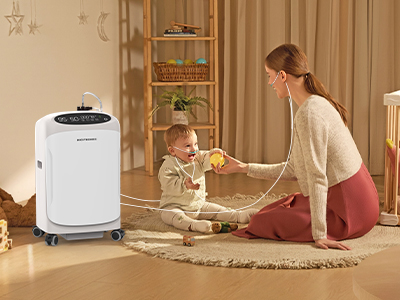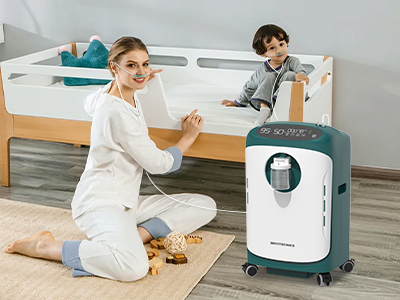09 May 2025
The moment a newborn draws its first breath is one of life’s most miraculous milestones. But for some infants, breathing isn’t automatic—it’s a challenge. Their developing lungs may struggle to absorb the oxygen their growing bodies desperately need. In these moments, oxygen therapy is not just helpful—it’s lifesaving. Recognizing the signs early can change outcomes dramatically and ensure your baby thrives rather than just survives.

Persistent Rapid Breathing (Tachypnea)
One of the earliest and most telling signs of respiratory distress in infants is tachypnea—an abnormally fast breathing rate. While newborns normally breathe a bit faster than adults (about 40–60 breaths per minute), consistently exceeding this pace should raise eyebrows. It’s your baby’s body trying to compensate for inadequate oxygen by working overtime.
The chest may appear to pump like a tiny bellows, rapidly and relentlessly. This is not just a quirk of infant behavior. It is often a red flag waving in sync with each breath.
Flaring Nostrils and Retractions
Babies communicate in curious ways. When breathing becomes difficult, their nostrils may flare with each inhale—a miniature signal of distress. Simultaneously, retractions might appear. These are visible indentations of the skin around the ribs and sternum, where soft tissue gets sucked inward during each breath.
Both signs indicate that the lungs are under strain and struggling to meet oxygen demands. It’s as if the body is fighting for air, pulling it in with every ounce of effort it can muster.
Bluish Tint to Skin, Lips, or Fingertips (Cyanosis)
Color is a powerful diagnostic tool. If your baby's lips, tongue, or fingernails begin to take on a bluish or purplish hue, it could signal cyanosis—an ominous sign of low blood oxygen levels. In fair-skinned infants, this discoloration is usually easy to detect. In darker-skinned babies, the inside of the lips or the whites of the eyes may be more telling.
This isn’t just a cosmetic change. It’s a visual siren. Cyanosis is a sign that vital organs may not be receiving enough oxygen, and intervention is often urgent.
Poor Feeding and Fatigue
Feeding is one of a newborn's most energy-demanding activities. If your baby tires quickly while nursing or bottle-feeding, pauses frequently, or seems uninterested in eating, it could be due to inadequate oxygen levels.
A well-oxygenated baby typically feeds vigorously and with focus. One who is oxygen-deprived may appear lethargic, disengaged, or unable to coordinate sucking and breathing. Fatigue, in this context, is not mere drowsiness—it’s a physiologic cry for help.

Frequent Pauses in Breathing (Apnea)
Apnea, or brief pauses in breathing, can be terrifying to witness. While occasional pauses are normal for very young infants, frequent or prolonged episodes are cause for concern. These interruptions may reduce oxygen supply to the brain and other organs.
Oxygen therapy can help stabilize these patterns, particularly in premature infants or those with underdeveloped neurological respiratory control. Monitors may help catch these pauses, but attentive observation is equally critical.
Low Oxygen Saturation Levels on Monitoring
Pulse oximetry—a simple, non-invasive test using a sensor on the foot or finger—measures the percentage of oxygen in the blood. For most healthy infants, oxygen saturation should stay between 95–100%. Levels consistently below 90% are a major warning sign.
Doctors use this data as a cornerstone in determining the need for oxygen therapy. It's one of the few objective, measurable tools that directly reflects how well your baby is oxygenating.
Chronic Lung Conditions and Prematurity
Some babies are born with a steeper hill to climb. Preemies, especially those with bronchopulmonary dysplasia (BPD), often require supplemental oxygen to support underdeveloped lungs. In these cases, oxygen therapy isn’t just a reaction—it’s part of a long-term care plan.
Other chronic conditions like congenital heart defects or respiratory infections can also deplete oxygen levels. In these contexts, supplemental oxygen acts as both a treatment and a protective barrier against complications.
Physician Evaluation and Diagnosis
The signs may start at home, but the decisions should rest with trained professionals. Pediatricians and neonatologists assess multiple factors: physical signs, oximeter readings, lab work, and imaging studies.
If oxygen therapy is deemed necessary, it may be administered in a neonatal intensive care unit (NICU) or even at home through portable equipment. The goal is always the same—stabilize, support, and strengthen the baby’s ability to breathe unaided.
Conclusion: Supporting Your Baby’s Breath, Every Step of the Way
Breathing is life’s first and most essential task. When that task is compromised, oxygen therapy becomes an invisible but powerful ally. Watching for the signs—rapid breathing, cyanosis, poor feeding, apnea—can be the difference between delay and decisive care.
Your vigilance, paired with professional insight, ensures your baby is not just breathing—but thriving.
But support is everywhere. Counseling, peer support groups, mindfulness apps, and even journaling can help recalibrate your mental landscape. You are not defined by your equipment; you are defined by your resilience and how you rise, breath by precious breath.
Emergency Preparedness and Backup Plans
What happens if the power goes out? If you’re using an electric concentrator, a blackout could cut off your oxygen source. That’s why backup oxygen tanks—preferably filled and easily accessible—are non-negotiable.
Keep batteries charged for portable concentrators. Know where the nearest emergency services are. Build a kit: extra cannulas, masks, extension tubing, a flashlight, batteries, and copies of your oxygen prescription. Planning for the worst ensures you breathe calmly through anything.
Conclusion: Redefining Independence with Every Breath
Home oxygen therapy is not a limitation. It’s a liberation. With each inhale, you’re reclaiming autonomy, pushing boundaries, and writing a new script—one rich with potential and perseverance.
Transitions are rarely effortless, but with preparation and the right mindset, they become transformative. So take that first step. Breathe in. Move forward. Home is ready—and so are you.
Keywords: oxygen therapy
Originally published 09 May 2025, updated 09 May 2025.